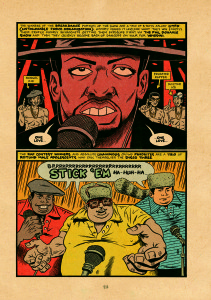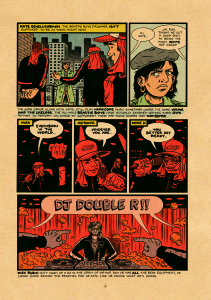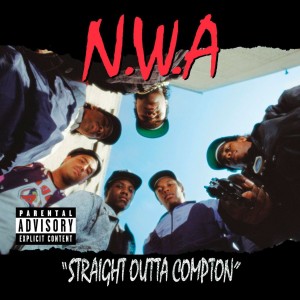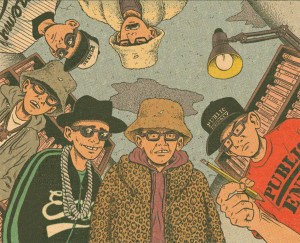Acclaimed comic book artist Ed Piskor’s Hip Hop Family Tree series is as fresh and electric as the music it salutes. This newest endeavor from Eisner-nominated Piskor explores the world from which he emerged to become the heir apparent to renowned underground comics artists Harvey Pekar (with whom he has collaborated) and R. Crumb. Hip Hop Family Tree Vol. 1 (1970s-1981), published in 2013, detailed hip hop originator Kool Herc’s revolutionary rec room parties in the summer of ’73, while the upcoming installation, Hip Hop Family Tree Vol. 3 (1983-84), tracks the rise of hip hop super stars the Beastie Boys and RUN-DMC.
We caught up with Piskor straight off the Copenhagen Comics Festival to, uh, rap about the past, present, and future the still-growing Hip Hop Family Tree.
What’s your history with hip hop and comics?
I was born in ’82 so hip hop was a fad all around the country at that stage. I grew up in a predominately black neighborhood and rap music was just all around me. My folks didn’t like rap, so that made me way more attracted to it than I probably would have been otherwise. They didn’t have a lot of cash to throw around but they still managed to spoil me like crazy so I had plenty of comics. So basically I was born into hip hop and comics.
I was DJ’ing school parties and roller rinks before I was old enough to shave, at the same time I was still totally into Spider-man comic books. So Hip Hop Family Tree is right up my alley.
It’s funny that you mention the roller rink scene because so much of what I’m covering now and will be covering soon, I remember from skating rinks. Like Newcleus, “Jam On It”? That’s synonymous with roller skate jams.
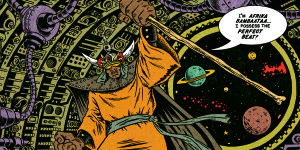 Hip hop, electro and freestyle still rule the rinks today. Debbie Deb, Pretty Tony, “Planet Rock”. That’s roller jams.
Hip hop, electro and freestyle still rule the rinks today. Debbie Deb, Pretty Tony, “Planet Rock”. That’s roller jams.
I love that stuff.
So how was the series born?
There’s something that really excites me about the imagery of old hip hop. The aesthetic of graffiti and fashion – I love 70’s New York films like Scorsese flicks and The Warriors. For years I’ve been trying to figure out how I could incorporate all that imagery into a story. All of a sudden I decided I would do a linear history of rap music. I knew that would be a great template for all of this stuff I wanted to draw.
Where did hip hop begin?
The commonly accepted answer would be the South Bronx. By virtue of that, the “Family Tree” can take shape and flourish. The smaller regions, where Kool Herc played parties — the next generation of hip hop attended those parties. The neat thing is that everybody is related in some form or fashion whether they want to be or not. So the comic is really an exercise in deconstructing the culture and rebuilding the world step by step, to show everybody, including myself, all of the circumstances that were required to make hip hop what it is today. Because a lot of things had to happen in a very specific way for it to become a big deal.
Hip Hop Family Tree really gets meticulous into the history. How did you research these stories as far as who was the first scratcher or that first MC to say “throw your hands in the air and wave ‘em like you just don’t care!”
The first volume is entirely from resource material – every book on the subject I could get my hands on, every interview from magazines or websites, You Tube interviews. Anything. And I try to present it in a very honest and journalistic way. I have multiple sources that I cite for each specific moment. I’m sure you know, anonymous douchebags are very happy to get online and tell you if you get something wrong. So I like to have artillery.
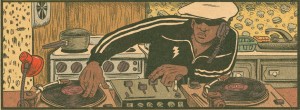 Did hip hop grow out of disco?
Did hip hop grow out of disco?
It’s interesting. You had a very finite number of black radio stations in New York and certainly around the country and they were programmed by crusty old white guys who had no ear to the street. They weren’t playing things that people were actually listening to. They were playing nonsense disco stuff. So hip hop almost came about like a rebellion to disco. The reason Kool Herc started playing parties and spinning records is because he wanted to play the music people actually responded to and resonated with rather than the typical disco du jour that was being pumped out on radio.
And with the clubs, soon as disco went out of fashion, the owners still need to get people in the door. So that’s when they started bringing in hip hop artists in the early 80s.
“King Tim III” by Fatback is considered to be the first recorded rap song, and Blondie’s “Rapture” is the first #1 song and video to feature rap. Talk about the importance of those records in the emergence of hip hop.
In all the research I’ve conducted, there’s not one person that stated they decided to become a rapper after hearing “King Tim III”. So I can’t speak on that very much. What I can say, is there were some lyrics on that record like, slam dunk, do the jerk, let me see your body work – well, every junior varsity cheerleading squad used that phrase. Or they certainly did when I was a kid. So maybe it was like “Mickey” in that regard?
Blondie served a way more important function because for all its corniness with Debbie Harry talking about eating cars – that song was like a gateway drug for white people to get introduced to rap music.
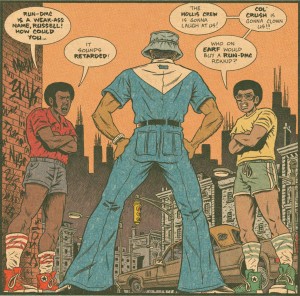 The early battles — like between Grandmaster Flash & his 3 MCs versus Brothers Disco & the Funky Four — how did those work?
The early battles — like between Grandmaster Flash & his 3 MCs versus Brothers Disco & the Funky Four — how did those work?
The earliest battles were more about decibel levels. It had almost nothing to do with rap. In fact, it had almost nothing to do with musical choice, it was literally who could be heard the best. Everybody was poor so there were no professional operations, the equipment was all rigged, just whatever you could throw together and come up with.
How did they decide a winner?
Best I understand it would be a gym setting, like on a basketball court. One crew would set up under one hoop, the other crew would be under the opposite hoop. They would play back and forth and the dancers would gravitate to the side they could hear the best. So it was visually obvious who the winner would be. The fun thing about those battles is you’re not necessarily winning much beyond prestige. Just bragging rights.
After the volume was taken care of it became about musical choice. That’s when a DJ had to be more defensive about his cuts, hiding the labels and resorting to trickery. Afrikka Bambaataa would put the labels from one record onto another so people would buy the wrong shit. Then in later years MC’ing became a more predominant part of the party.
Just for fun –in the era of MC’s, a battle in their prime: RUN-DMC vs. The Beasties. Who wins?
I would say RUN-DMC for the simple fact that they wrote several songs off Licensed to Ill. The Beasties never wrote rhymes for RUN-DMC. So I think RUN-DMC would own that one.
What do you think are the 3 most important records in hip hop?
I can’t really categorize them this way. I think that the person who is doing a project like mine needs to keep very objective and I think that there isn’t a series of records that a big consensus would agree on as being an outlier. Except for Illmatic.
I’m just a roller rink DJ but I’ll give it a shot… 1) Run DMC — King of Rock 2) Beastie Boys — Paul’s Boutique 3) Hmm. De La Soul? Public Enemy? Biggie? Eric B. & Rakim?
How about the 3 most important moments in hip hop history?
I think my thesis of the whole comic series is that everything is really really important for getting hip hop where it is today, but to just have fun and play along:
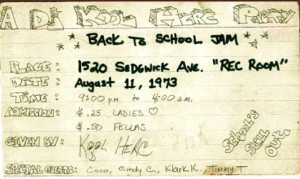 1. Kool Herc’s early jams at 1520 Sedgwick
1. Kool Herc’s early jams at 1520 Sedgwick
2.”Rapper’s Delight” (for acting as a catalyst for others to produce more music).
3. Yo! MTV Raps for creating a vector for people outside of the hip hop niche to discover the music and artists.
I found it really interesting that the originators of hip hop hated “Rapper’s Delight.”
Just by nature of evolution, the originator often doesn’t benefit. Evolution is about building upon previous work. Taking all of the best that came before you and moving forward. And that’s basically how “Rapper’s Delight” came to be. The Sugarhill Gang pilfered everything they could get their hands on – Big Bank Hank in particular – but they were outsiders. Nobody on the streets knew who they were but they recognized everything they were talking about. So the Sugarhill Gang was almost like the first incarnation of Iggy Azalea. I just put that together while we were talking but it’s the same argument. They’re not from Australia but they were from New Jersey and that was far enough away from the South Bronx for people who were into hip hop to not believe it was authentic.
Where will you take the series from here?
In Volume 4 things are starting to ramp up so I’ll be introducing a lot of new characters. Schoolly-D, Fresh Prince and Jazzy Jeff, there’ll be a lot more West Coast because things were starting to get really interesting there. A group that really needs to be talked about from the 80s are the biggest drug dealers on both coasts. Like Freeway Ricky Ross? He owned L.A. crack distribution and funded young hip-hoppers, bought them turntables and equipment.
On the East Coast, the major New York drug dealers influenced the fashion, the glitz and glamor of the hip hop industry because they were so much richer than the rappers at the time. They never made a record but they were bigger stars than LL Cool J. The rappers started to emulate the drug dealers of that era so they have to be covered as well.
So eventually we’ll see 2 Live Crew, N.W.A., Tupac and Biggie?
Definitely. Did you know that 2 Live Crew was a West Coast L.A. based group before they went to Miami?
I don’t think I did.
2 Live Crew had almost like an early Streisand effect when Tipper Gore was mentioning their name every two seconds and talking about how bad they are. Well, of course every teenage kid is going to want to hear that! But they had a record in ’84 that you wouldn’t imagine would be 2 Live Crew. This was an era when a lot of music was pushing a positive message. Not to say that their other music was necessarily a negative message but . . . well, scratch that. Never mind. (laughs) So yes, 2 Live Crew will be in book 4.
.

